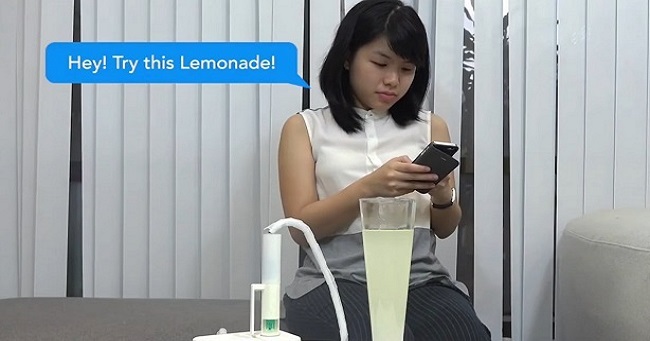


People have always wondered when the internet will be used to send physical things from one place to another. The technology is advanced enough to make a 3D printed body part, but not advanced enough to send food and drinks across internet. However scientists in Singapore have devised a way to send the feel and taste of a drink using electronics and internet, which may be used to send food and drinks using internet in future.
Check out the video in the slides.
Scientists have become successful in sending a drink over internet. They conducted a successful experiment in which they were able to send the sourness of lemonade to another glass of water, using just internet. The scientists are a part of group at the National University of Singapore, headed by Nimesha Ranasinghe.
The team recently presented their findings in a conference in Japan and technology, which is in its infancy has its drawbacks. “Unless you simulate olfaction, true flavor cannot be reproduced,” says Amol Bhondekar at the Central Scientific Instruments Organisation in India. Ranasinghe and his team used sensors and colors to measure the color and pH of freshly poured lemonade.
This data was then transmitted via internet to a recipient glass, filled with water and fitted with sensors and LED to mimic the color of lemonade. Watch the whole experiment with your eyes in the next slide.

Image Source: www.cloudfront.net
Colors and acidity of the lemonade was captured by the sensors attached in the glass of real lemonade. This information was then uploaded to a digital tumbler at the receiver’s end, which was also connected with sensors and LED lights. Internet was used to transmit this data and electrical stimulation tricked the taste buds into tasting the sourness, while LED lights mimicked the color of lemonade.
The scientists used 13 people to taste the real and virtual lemonade, without informing them which was real and which was virtual. Results revealed that though majority of participants tasted the real lemonade, they said that virtual lemonade was much sourer than the real one.
This technology has many uses and a firm has already started working towards making the best use of it.
An LA firm has started the Project Nourished which is aimed at using this technology to help people who are concerned with numbers of calories consumed or people who have dietary illnesses, eat their food without worrying about anything.
They plan to use aromatic diffusers, bone conduction transducers, gyroscope utensils, virtual cocktail glasses and 3D printed food. The user will be given a virtual reality headset and bone conduction transducers will mimic the chewing experience. The aromatic diffuser will give you the smell of food using heat sensors.